162d General Hospital Unit History
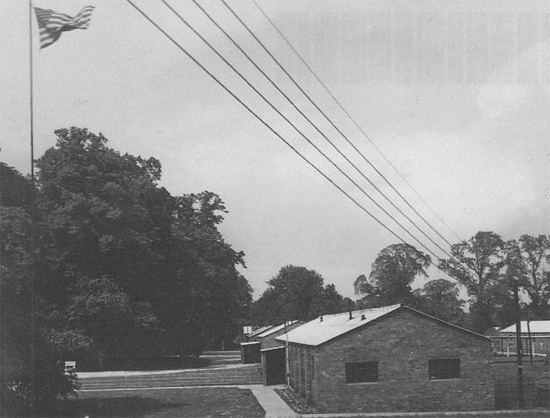
Partial view of the 162d General Hospital at Nocton Hall, Nocton, Lincolnshire, England in 1944. Flag mast and Headquarters buildings are illustrated.
Activation and Training:
The 162d General Hospital was authorized on Saturday, 1 July 1944. Following General Orders 128, the new Hospital was to be activated at Cp. Grant, Rockford, Illinois, one of the large Medical Replacement Unit Training Centers in the Zone of Interior. The Camp had a troop capacity for 20,836 men, and thousands of Enlisted Men with hundreds of Officers from all over the country were busy with pre-activation training. The Officers acted as instructors and taught basic medical subjects to the Enlisted Men who came from Station Hospitals and other medical organizations throughout the country. The majority of the Officers came from the Eighth Service Command, with a few transferred from the current pool at Cp. Grant. Practically all the Nurses came from the First Service Command.
In the Camp’s Hospital, Army Doctors continued to teach and practice the safeguards so vital to the men’s health. Field medical records, treatment of gas casualties, litter drill, ambulance loading, field sanitation, medical and surgical nursing, general medical care and aid were handled. Physical development was highlighted; this most important part of training was the one method to harden green soldiers to withstand the rigors of field service and combat. Drill, road marches, calisthenics, and an organized athletic program took place on a regular basis; military courtesy and discipline, personal hygiene and first aid, care of clothing and individual equipment, individual defense against chemical, air, and mechanized attack, interior guard duty, bivouacs, tent pitching, entrenchment and shelter, entrucking and detrucking, scouting and patrolling, orientation and compass use, technical and tactical employment and deployment of medical field units, and other topics were included in the training courses.
Everyone was aware that the Hospital was due to move overseas and personnel tried to prepare for all eventualities. Possibly the only hint to a future destination was the request for winter clothing.
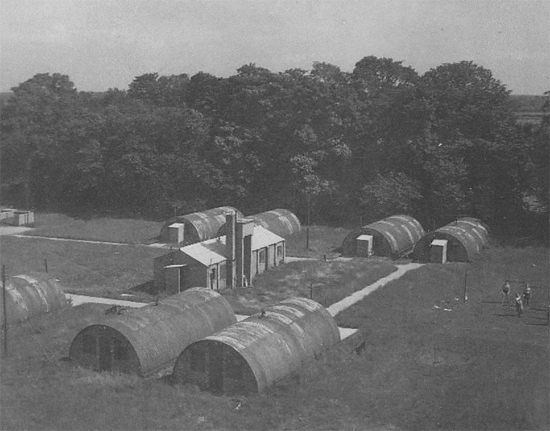
View of Officers’ Quarters, 162d General Hospital, Nocton Hall, England.
Preparation for Overseas Movement:
At first P.O.M. requirements stood like insurmountable mountains. It was during this formative period that the 162d General Hospital Commanding Officer, Lt. Colonel Eugene J. McCann, M.C., O-275787, showed his excellent guidance and never-failing advice. During this preparation, the unit trained under Mobilization Training Program (MTP) 8-2, 1 July 1944. There were numerous classes, training films, long hikes, and finally, several days of bivouac. The entire Hospital went into the wilds around Cp. Grant to set up heavy tents and operated under field orders. The unit’s Supply Officer was to provide the necessary clothing, medical supplies and equipment for the entire organization, he even had to borrow a typewriter to prepare his first requisition. An advance party, consisting of 2 Officers and 3 EM left in order to prepare the next journey for the remainder of the unit.
Staging Area:
After a large farewell party, the Hospital received its “Call to the Port” instructions. The 162d Gen Hosp would now be designated as unit “2482-Y”. Alert orders came in on Friday, 18 August 1944, and by Sunday, 20 August 1944, the entire unit entrained (in two groups) to set out for its Staging Area at Cp. Myles Standish, Boston, Massachusetts (Staging Area for Boston Port of Embarkation –ed). Upon arrival, the men were set up in double-decker bunks in wooden barracks. The next day, processing began anew, personnel received typhus shots, impregnated clothing, and lightweight gas masks. Demonstrations were held to show how to abandon ship in case of emergency, and how to protect oneself against chemical warfare. Training films were included such as “Why We Fight” and “Our Allies”. Some passes were distributed to visit Boston, the nearest large town. The Hospital was alerted on Sunday evening, 27 August 1944, and instructed to entrain for the last move to the port area. After detraining, personnel were given coffee and donuts by Red Cross girls, and all marched single file, after having been checked by roster, onto the ship.
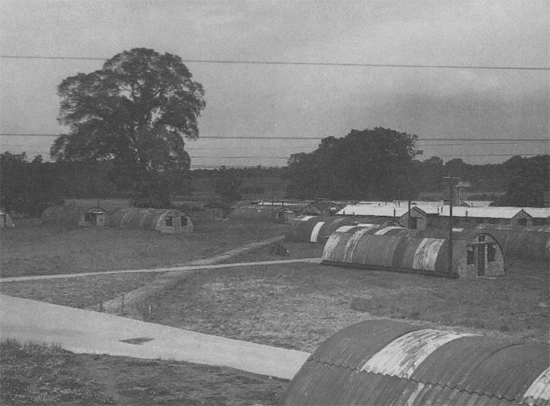
View of Enlisted Men’s Quarters, 162d General Hospital, Nocton Hall, England.
On the Move, Destination Overseas:
The ship, S/S Mariposa, now a gray-painted ex-luxury liner, was to become the 162d Gen Hosp’s home for the journey across the Atlantic which started 30 August 1944. Every available space seemed to have been converted for the purpose of carrying a maximum number of personnel. Officers and Nurses slept as many as thirteen to a single cabin, in bunks, three high. EM had less comfort. It should be noted that the ship’s Dispensary, Hospital, and Pharmacy were manned by the unit’s own personnel. Very few people became seasick during the voyage, although the mere sight or smell of food did affect some. The men and women ate in shifts of five, and there were only two meals a day.
1944 – United Kingdom:
On 6 September 1944, Northern Ireland was sighted. About 1700 hours, the vessel entered Liverpool harbor. After docking at approximately midnight, a number of Officers and Enlisted Men debarked, the Nurses, the remainder of Officers and EM remained on board until the next morning. The next destination was Kettering, in Northamptonshire. Officers and Enlisted personnel were to move to Kettering, while the Nurses were split into three main groups that went to several General Hospitals throughout southern England. The advance party, already at the transient camp, had made the necessary preparations for quarters. The unit was housed in pyramidal tents set up on the Duke of Buccleuch’s estate. K-rations were served because no mess facilities were yet available, and latrines and sewage needed some immediate attention, the camp only held a mobile kitchen which supplied the necessary bread. The group remained confined to the area for a period of about ten days, awaiting the arrival of personal luggage and TAT equipment.
On receipt of Movement Orders No. 91, Headquarters, United Kingdom Base, an advance group of 26 Officers, 30 Nurses, and 150 Enlisted Men, accompanied by 2 Physical Therapists, and 2 Hospital Dietitians set out from Kettering by truck to the final destination, which was to be Nocton Hall, Lincolnshire. After arriving at the fixed installation, where also the 7th General Hospital was established, the advance party gradually took over control of the various existing departments. On 17 and 18 September, the remainder of the organization arrived. Gradually, the unit took over and assumed full responsibility, and by 21 September 1944, the 162d General Hospital was officially in charge of the site. Apart from taking over Army Hospital Plant 4201, there were a few other separate units on site, such as a Signal Detachment (1 Officer & 13 EM), a Finance Detachment (110th Finance Disbursing Section with 1 Officer & 5 EM), and a Rail Transportation Office (2 EM). The main purpose of the 162d Gen Hosp was the treatment of combat and non-combat casualties, with patients being evacuated (1) to duty, (2) to the ZI, (3) to another medical establishment for more specialized care. In general the unit was defined as being a holding Hospital where patients were concentrated while awaiting transfer to the Zone of Interior.
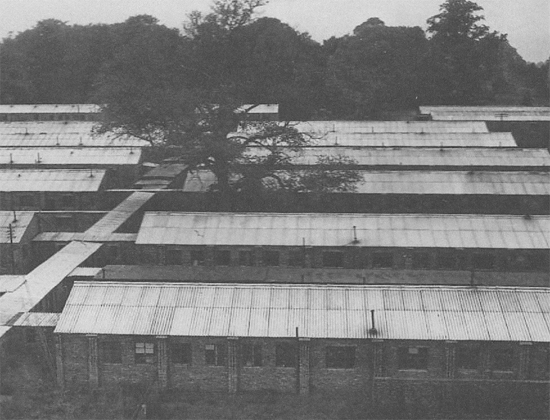
View of the Surgical Section, 162d General Hospital, Nocton Hall, England.
The 162d General Hospital was established as per T/O & E 8-550, dated 1 April 1942, Change 4, numbering: 37 Medical Corps Officers, 5 Dental Corps Officers, 8 Medical Administrative Corps Officers, 2 Quartermaster Corps Officers, 2 Sanitary Corps Officers, 2 Chaplain Corps Officers, 1 Warrant Officer, 83 Nurses, 2 Physical Therapy Aides, 2 Hospital Dietitians, 450 Enlisted Men, and 5 American Red Cross personnel (the current aggregate read 38 MC Off, 5 DC Off, 8 MAC Off, 2 QMC Off, 2 SnC Off, 2 ChC Off, 1 WO, 82 ANC, 2 PTA, 2 HD, 451 EM, 5 ARC). The following changes were however in effect: 1 AAF Medical Major was attached, 2 MC Lieutenants were on DS with the 82d A/B Division, with some more Officers transferred to other medical organizations.
| Major Staff – 162d General Hospital | |
| Lt. Colonel Eugene J. McCann, MC, O-275787 | Commanding Officer |
| Lt. Colonel Arthur N. Lewis, MC, O-225183 | Executive Officer |
| Captain Alfred A. Gilligan, ChC, O-526721 | Catholic Chaplain |
| Major Leone G. Piekarski, ANC, N-726735 | Chief Nurse |
| Major Harry M. Scott, MC, O-491779 | Chief Medical Service |
| Major Julius Abramson, MC, O-407598 | Chief Surgical Service |
| Lt. Colonel Clarence F. Albers, DC, O-140774 | Chief Dental Service |
| First Lieutenant Joseph D. Danahar, MAC, O-1545936 | Detachment of Patients |
| Major David P. Lauer, MC, O-360500 | Admissions & Dispositions |
The actual layout of the Hospital consisted of permanent structures (brick buildings, built, owned, and maintained by the British) with a capacity for 1,254 beds, connected by concrete roads, and a number of tents, owned and maintained by the US Army. Most of the equipment was the one left behind by the 7th General Hospital. Both Officers and Enlisted Men lived in Nissen huts, heated by a single pot-bellied stove. Nurses were quartered at Nocton Hall, in a three-story partially-renovated old castle. Three large Mess Halls were available, for respectively Officers, Patients, and Enlisted personnel. Sanitation was satisfactory and most buildings were supplied with hot and cold running water and flush latrines. Water supply was adequate and obtained from nearby wells.
The Regional Transfusion Laboratory in Nottingham supplied the Hospital with whole blood. It was obtained citrated in bottles and ready for use, and originated from donations by British volunteers. 23 British civilians were employed by the unit for construction and maintenance works, with 3 women used for clerical work. Wages for this group came from British funds. The American Red Cross and Special Services received invaluable assistance from the British Ministry of Information and the Women’s Volunteer Services, which arranged for amusements, parties, tours, receptions for the ambulatory patients. British Service Women were often invited together with British civilian girls to dances organized by the unit.
One of the greatest tasks fell upon the 162d General when on 10 October 1944, Hospital Train No. 14 arrived with 273 patients, consisting of 55 litter and 218 ambulatory cases. As the unit was notified one day in advance, it was possible to make the necessary arrangements for admission. Contact was made with the 184th General Hospital and the British Red Cross for additional ambulances. A boarding party went ahead to Nottingham Victoria Station, to meet the train arriving at 1630. En route, the Medical Officers numbered and divided the patients into different categories so that upon arrival in Lincoln at 1900 hours, the railhead party knew what was coming. The unloading started at 1915 and was completed at 2025, and by 2345 hours, all admissions were recorded. Ambulatory patients were fed in the Mess Hall and bed patients received their food in their wards.
While stationed at Nocton Hall, training and schooling never stopped. Two MC and one DC Officer as well as 2 Nurses were sent to the American School Center (located at Shrivenham –ed) to catch up with the latest information on Military Medicine, Chemical Warfare, and Field Sanitation. One Enlisted Man followed a correspondence course, and others attended Cooks and Bakers School. Instructors mainly consisted of American Officers and NCOs with occasionally a few British instructors for specialized subjects. Recreation was provided by way of movies, shows, reading, writing, games, dances, and concerts. Members of the Royal Family and high-ranking British Officers paid formal visits to the Hospital’s installations.
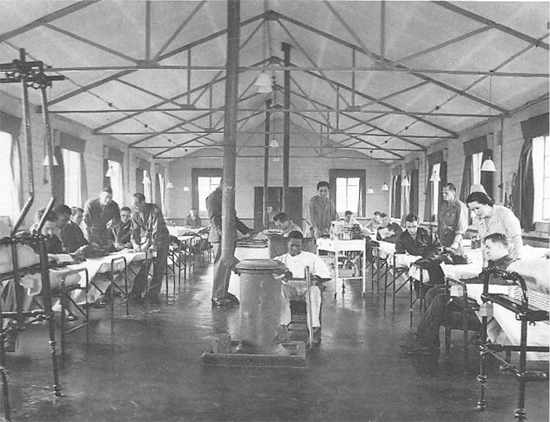
View of one of the Surgical Wards, Post-Operative Section, 162d General Hospital, Nocton Hall, England.
On 11 November, the 162d Gen Hosp was assigned to the VII Hospital Group (Provisional). In the latter part of November 1944, for a period of three weeks, the 513th and 518th Medical Hospital Ship Platoons, consisting of 1 Officer and 15 EM each, were stationed with the 162d. They assisted the various sections of the Hospital during this short interval. The designation of the former Holding Hospital was meanwhile changed to that of a “Concentration Point” and on 22 December, the Hospital was now part of the 805th Medical Service Detachment or 805th Hospital Center (Hospital Centers were created to simplify control of the largest clusters of General Hospitals stationed in Britain, the Chief Surgeon therefore activated the new organizations which were designed to coordinate and assist the work of a variable number of General Hospitals, the 12th and 15th HC were activated in May 1944, followed by the 804th and 803d HC in June, and eventually by the 802d, 801st and 805th later in the same year –ed). This change was confirmed with Memorandum No. 14, dated 26 December 1944. In its new capacity, the 162d Gen Hosp now concentrated patients from the 184th General and the 384th Station Hospitals. For a certain time, the number of EM personnel increased up to 487 (while T/O & E prescribed 450). This was due to the arrival of a group of 37 Enlisted Men in the latter part of December, all battle-casualties designated for one or another reason for limited duty. Some exchanges took place in the Officer staff, whereby Lt. Colonel Jackson K. Holloway, MC, O-508229, took over responsibility for the Surgical Service; Major George P. Wyman, MC, O-284620 came in as Chief of the new Neuro-Psychiatric Section, with another Major becoming attached as Flight Surgeon. Captain Charles N. Mell, MC, O-522705 was appointed Chief of Orthopedic Service.
The British were most accommodating in many ways, with some of the supplies being obtained directly from them under Reverse Lend-Lease. Medical and combustible gases were supplied, stoves and solid fuel were delivered, the electricity was provided by the Lincolnshire Electrical Company, laundry was done outdoors, and some cleaning and maintenance equipment was purchased from local sources. American-British friendship was running high, with one of the finest gestures being the organization of a Christmas party and open house for the nearby parishioners and their children. Gifts were exchanged and rations shared.
The overall workload gradually increased, with personnel learning and acquiring new techniques, and improving organizational methods and procedures. During October 1944 – December 1944, 5 Hospital Trains arrived with their load of wounded. The majority of these trains started from southern England after the patients had been evacuated by sea or air from the continent. Between September 1944 – December 1944, the unit serviced about 4,000 patients. At one period of time, 300 ambulatory cases evacuated from France by air arrived in 11 C-47 cargo planes. Meanwhile personnel continued to concentrate on patients received from the 184th Gen Hosp and the 384th Sta Hosp for evacuation to the ZI.
| Zone of Interior Dispositions | |||
| Month | Air | Sea | Total |
| October 1944 | 277 | 132 | 409 |
| November 1944 | 230 | 41 | 271 |
| December 1944 | 308 | 183 | 491 |
Surgical Service treated 1,917 cases. By the end of 1944, an ever increasing number of patients with trench foot were received by the Medical Service. Dental Service provided all the necessary dental work and reported 1,300 fillings, 150 dentures, 250 extractions, and 1,100 X-rays. ANC personnel numbered 84 Nurses, who worked based on a service rotation. Storage of supplies was worked out with a target of maintaining a 90-day supply. Transportation remained limited, and it was amazing that a vast amount of work could be done with a relatively small amount of equipment. The Hospital only had 24 vehicles and 2 trailers, consisting of 5 2 ½-ton cargo trucks, 6 ¾-ton ambulances (and 8 British ambulances), 4 ¼-ton trucks, and 1 ½-ton cargo truck, which could unfortunately not perform all the unit’s requirements. Due credit should be given to other organizations for providing extra transportation and personnel (primarily the British Red Cross in Lincoln, and the 184th General Hospital). Supplies were mainly received from a number of Depots in the region; G-18 at Sudbury (medical supplies), G-23 at Cambridge (quartermaster supplies). The Post Exchange was very complete and drew its items from the Q-101 Depot. It was an excellent morale booster and among its precious assets was one of the few Coca-Cola fountains in the E.T.O. As far as new developments were concerned, a laundry was under construction.
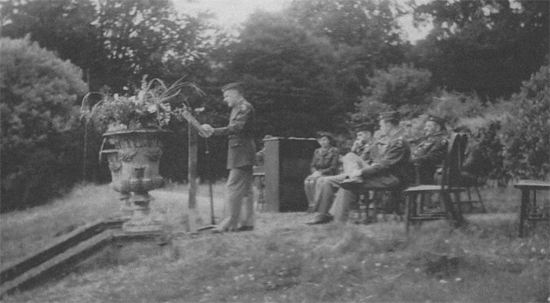
Official address by Lt. Colonel Eugene J. McCann, MC, Commanding Officer, 162d General Hospital. Occasion: Fourth of July 1944 celebration.
Under the guidance of Miss Doris E. Hudson, Assistant Field Director, the A.R.C. tried to make the patients’ stay at the Hospital a more pleasant one. Morale was important and a number of extra services were provided with the full cooperation of the Nurses; communication with the family and relatives of the patients, loans of money for purposes of transportation, handicraft services and material, games, books, movies, birthday parties, dances … regular appearance of the Red Cross Cinemobile and Red Cross Clubmobile were encouraged.
On 6 December 1944, the different Hospital sections successfully passed a number of inspections – taken as a whole the rating of the 162d General Hospital was deemed excellent.
1945 – United Kingdom:
On 3 February 1945, the unit received notice from Headquarters, United Kingdom Base, ETOUSA, “that General Hospitals under the jurisdiction of the 805th Hospital Center be immediately reorganized under column 4, T/O & E 8-550, dated 3 July 1944.” This entailed a number of changes. The new T/O included the following personnel:
32 Medical Corps Officers, 6 Dental Corps Officers, 10 Medical Administrative Officers, 2 Sanitary Corps Officers, 3 Chaplain Corps Officers, 1 Corps of Engineers Officer, 1 Branch Immaterial Officer, 83 Army Nurse Corps Officers, 3 Physical Therapy Aides, 3 Hospital Dietitians, 450 Enlisted Men, and 5 American Red Cross workers.
It was also added in Paragraph 2b of subject instructions “that each organization concerned was to, without delay, render a report of excess personnel to the Commanding General, Ground Forces Redeployment Command (Rear), APO 413, through Headquarters and the Chief Surgeon.”
On 11 February, a request was received from Headquarters for a “Report of Officers desiring Reassignment to Army Ground Forces.” (Medical personnel belonged to the Army Service Forces –ed). The C.O. of the Detachment of Patients was a candidate and desired a transfer. Meanwhile other Officers had been lost by transfer to other medical organizations, with a few others having been returned to the ZI because of illness. Some were replaced although not all losses could be compensated. Promotions resulting in change of ranks and appropriate pay were welcomed. For short period, some members were on TD while accompanying patients to the various Ports (or Airports) of Embarkation.
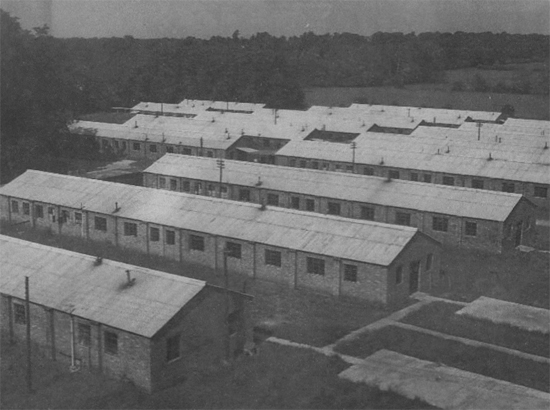
View of the buildings housing the Medical Service, 162d General Hospital, Nocton Hall, England.
The Hospital underwent a constant replacement of general assignment Enlisted personnel. Upon receipt of the necessary directives in March 1944, designated ‘Retraining as Infantry Rifleman”, Headquarters, United Kingdom Base, ETOUSA, the 162d General sent several groups of men to the “Ground Forces Reinforcement Command”. The majority of these men were then trained as riflemen and placed in Infantry units, while those showing special skills were sent to forward medical installations. In total, 78 EM were sent out (January – March 1945) but replacements were not always forthcoming, such that on 31 March the total number of Enlisted Men only reached 425 (in lieu of 500).
On 3 March, Major General H. B. Vaughan, Jr. (CG > United Kingdom Base, ETOUSA), visited and inspected the 162d General Hospital. He was accompanied by Colonel G. D. Wiltshire (CO > Eastern District) and Colonel R. E. Chambers, MC, Commanding Officer, 805th Hospital Center. After a successful and extensive inspection tour, the General commended Second Lieutenant William L. Royster, MAC, O-2049079, Mess Officer, awarding him the Bronze Star Medal. General Vaughan remarked that the Hospital could probably use some PWs to some advantage in some of the work details around the station. Everything was found to be in superior condition.
The war actually came to the Hospital’s doorstep in the early part of March 1945. Several air raid alerts had been received in the past, but at 0015, 4 March, the unit received a ‘red signal’ (danger imminent) from the ARP controller in Lincoln. The sirens on the post sent forth a wavering blast, and it was then noticed that an aircraft was overhead firing its guns in the direction of the Hospital. It was a rather dark night and the installations were completely blacked out, nevertheless, the strafing was repeated and bombs and flares were dropped several miles away (killing 2 people in a nearby town). At 0220 the ‘white signal’ was received (all clear). Empty shells were found the next morning near the medical supply building and on the front lawn, but no one was injured and no damage was reported. Winter was experienced accompanied by heavy snowfalls and very low temperatures, followed by rain and fog, which finally disappeared in the latter part of March. On 19 March 1945, Detachment G-839 of the Signal Service Company left the station. During the period of spring a large number of Medical Hospital Ship Platoons were stationed within the post. They were the 454th – 468th – 511th – 528th – 537th – 576th – 584th – 585th – 821st – 905th Medical Hospital Ship Platoons. Their Medical and Dental Officers assisted the 162d with its respective services while their Enlisted Men supplemented the personnel at work in the wards and other details.
Lt. Colonel Jackson K. Holloway, Chief of Surgical Service left the organization on 8 March on DS for Headquarters, United Kingdom Base, ETOUSA, and later returned to the United States on extended leave. He was duly replaced by Major Frank C. Shute, Jr., MC, O-1703681.
The Hospital was working at full capacity. Each department and section did its share in handling the large numbers of patients as smoothly as possible. 7 Hospital Trains came in during the first three months of 1945. Functioning as a “concentration center”, the unit not only received many patients from the 184th General Hospital, and the 384th Station Hospital, moreover, it admitted approximately 100 patients from the 36th Station Hospital which was being inactivated. The total number of patients admitted reached 2,020 of which only 949 were battle casualties (991 were returned to duty).
| Zone of Interior Dispositions | |||
| Month | Air | Sea | Total |
| January 1945 | 127 | 436 | 563 |
| February 1945 | 57 | 241 | 298 |
| March 1945 | 213 | 271 | 484 |
The patients were transported by ambulance to the nearby airfield (Metheringham) where they boarded the awaiting planes. Evacuation routes were altered; patients were now routed through Paris and then by plane (via Le Bourget Airport –ed) to the continental United States. During the first quarter of 1945, following awards to the patients were made by the Hospital Officers: 259 Purple Hearts, 29 Oak Leaf Clusters, and 1 Silver Star.
Surgical Service treated 1,389 patients, mostly general and orthopedic surgery cases. The majority were patients with combat wounds, who were brought in by Hospital Train for definitive treatment. They arrived anywhere from 5 to 15 days following injury, which implied that wound revision was necessary. The Medical Service admitted and treated 650 cases, among which came many patients with trench foot and neuro-psychiatric conditions. Following extensive treatment, out of 156 trench foot cases, 8 were returned to full duty, 127 to limited duty, and 21 to the Zone of Interior. No doubt that the rehabilitation program and the gradually longer hikes undertaken by the more fully recovered patients helped a lot. The whirlpool bath treatment handled by the Physio-Therapy Department also contributed. As the census of Medical patients decreased, there was a constant consolidation and unoccupied wards were closed, with patients moved to three wards in the Surgical section. Dental reports show that 1,679 fillings, 175 dentures, 232 extractions, and 1,300 X-rays were carried out in the period January 1945 – March 1945. A dental survey of the entire unit was completed in January (between 1800 and 2000 hours so as to not interfere with daily routine). Hypodermic syringes which had to be sterilized in an alcohol solution on the wards were now obtained, fully wrapped and autoclaved.
3 Nurses from the 36th Station Hospital were temporarily assigned to the 162d for one week together with one other Nurse from the 10th Reinforcement Depot. With patients census declining, more time was now allotted to training, including drill and hikes. Working hours were amended and reduced to allow for more off-duty time. Schedules in the wards were 0700 > 1300; 1230 > 1830; 1800 > 2300; and 2300 > 0700. The Transportation Officer was able to add 3 more vehicles to his Motor Pool. For supplies, it was no longer necessary to travel to the QMC Depots; the large quantities were requisitioned and arrived by train at the Nocton-Dunstan Railway Station, one and one-half miles away, resulting in a shorter haul to the Post warehouse.

Inside view of one of the Operating Rooms, Surgical Service, 162d General Hospital, Nocton Hall, England.
The Chapel which existed on the Post (brick construction) was used for services of all creeds. Services were provided by the 162d Gen Hosp Catholic Chaplain. Protestant and Hebrew Services were available, often by visiting Chaplains who were not assigned to the organization, but who came and went during the Hospital’s stay in the Theater. They all played a very significant and positive role in the Hospital comforting both personnel and patients with often difficult personal problems aggravated by war conditions.
A steel shed was constructed by elements of the 844th Engineer Combat Battalion for use as a gymnasium for the patients in rehabilitation as well as members of the own organization. It also served to house the display of the traveling PX Officers during their stay at the Post.
Entertainment and recreation continued to be offered as a morale booster. Special Services organized USO shows, ENSA shows, movies, concerts, lectures, and swimming contests. In addition, British papers, Stars and Stripes, Yanks, and Army Talks were available to everyone. Officers and EM held regular weekly dances, local orchestras were contracted and on two occasions the Band from the 163d General Hospital played for the organization. In March, an NCO Club was started. Baseball and volleyball were the games of choice weather permitting.
In addition to the regular conferences attended by the Medical Officers, new techniques and British medical methods continued to be developed and acquired. These included skin grafting and facial reconstructions, common fractures and application of plaster casts (organized at the 10th Station Hospital in the Manchester area), electro-cardiograph interpretation, and much more.
1945 – United Kingdom and Victory in Europe:
The END of the war was in sight, but jubilation caused by these victories was snatched by the shock of the sudden death of the Commander-in-Chief. On Friday, 13 April 1945, the death of President Franklin D. Roosevelt (32d President of the U.S., 30 January 1882 – 12 April 1945 –ed) was announced over the radio. All clubs and amusements were closed for several days and all flags were at half-mast. Memorial services were held in Lincoln Cathedral and more than fifty Officers and Enlisted Men attended. The newly appointed Commander-in-Chief, President Harry S. Truman (33d President of the U.S., 8 May 1884 – 26 December 1972 –ed), stated that he would continue the policies of his predecessor and conduct the war until final Victory.
As the pace of the war quickened, the enemy continued to retreat, and was defeated at every stand. Soviet troops continued to hammer at the gates of Berlin, and on 26 April 1945, both American and Soviet Allies linked at the Elbe River, cutting the Third Reich in two. The execution of Benito Mussolini (29 July 1883 – 28 April 1945 –ed) was announced, and the following days the German radio reported the death of Adolf Hitler (20 April 1889 – 30 April 1945 –ed). The Soviet Army captured Berlin and capitulation was at hand. In the early morning of 7 May 1945, representatives of the German High Command surrendered unconditionally to the Allies in a schoolhouse at Reims, France. The War in Europe was officially over …
The most significant change in policy came with a message from Headquarters, 805th Hospital Center, stating, “Effective 1 May 1945, the Theater evacuation policy to the Zone of Interior is changed from 90 to 60 days.” Also put into practice was a new SOP for “Reception, Processing, Maintenance and Disposition of Recovered Allied Military Personnel (RAMP).”

Inside view of the X-Ray Room, 162d General Hospital, Nocton Hall, England.
Total personnel strength, in view of the recent adaptation and reorganization of the United Kingdom Base, represented: 29 Medical Corps Officers, 6 Dental Corps Officers, 6 Medical Administrative Officers, 2 Quartermaster Officers, 2 Sanitary Corps Officers, 2 Chaplain Corps Officers, 1 Branch Immaterial Officer, 81 Army Nurse Corps Officers, 2 Physical Therapy Aides, 2 Hospital Dietitians, 433 Enlisted Men, and 5 American Red Cross workers.
The transfer of personnel to Infantry Regiments continued and the Hospital lost 1 Officer and 6 NCOs to the Officer Candidate School (O.C.S.). The organization was furthermore requested to supply personnel to other Hospitals serving on DS. 7 Nurses became assigned to the 250th General Hospital in France, and 10 Nurses went to the 303d Station Hospital in the United Kingdom. Several more Officers and Enlisted Men left the organization. Due to illness, Major Charles N. Mell, Chief of Orthopedic Service left on 25 April for the U.S. There were promotions for 10 Officers, including some Nurses, and 43 EM.
The decline of admissions continued, and the second week of April there were less than 100 patients in the wards. On 14 April, 5 planes carrying 17 litter and 83 ambulatory patients en route to Renfrew, Scotland, were forced to land at Metheringham. There was approximately one half hour notice in which to prepare for the patients to be admitted to the wards. They were handled and evacuated the following day by air to the ZI. The first batch of 10 American RAMPs was received on 16 April, together with another 264 patients. On 23 April, 45 litter and 195 ambulatory patients were admitted from the 115th and 116th General Hospitals as a final evacuation from these organizations which were to move shortly. A large group of 2,000 patients was received on 8 May 1945, V-E Day, including 155 RAMPs. The latter had to be first deloused with DDT and then isolated for 16 days after their first hospitalization. Dispositions by air included 11 shipments for April and 3 for May 1945.
| Zone of Interior Dispositions | |||
| Month | Air | Sea | Total |
| April 1945 | 238 | 169 | 407 |
| May 1945 (to 8 May 1945) | 101 | 155 | 256 |
The sudden change in numbers of incoming patients was solved by the rapid adjustment and the smooth running organization and its various departments. SOP # 58 was put into practice with the arrival of many more RAMPs, They had to fill out “War Crimes Questionnaires” under guidance of their ward Officers. The wounded received 75 Purple Hearts and 7 Oak Leaf Clusters.
The change in duration of the hospitalization period, i.e. from 90 to 60 days resulted in the transfer to the ZI of a larger proportion of the unit’s patients.
Dental Service handled less outpatients as many of the units in the surrounding area had either moved to other locations, or returned home. A total of 390 fillings, 22 dentures and repairs, 21 extractions, and 122 X-rays were carried out. With the sudden influx of patients, the Nurses went back to the old 8-hour day and 12-hour night shifts. Also a good number of them were transferred to other Hospitals on DS. There were two marriages, Second Lieutenant Alice Sironi, ANC, and Second Lieutenant Joan Creighton, PT.
In order to maintain the vehicles in the highest operating capacity and conservation, several new Standard Operating Procedures were instituted. The Transportation Officer attended Motor Maintenance School. Circular Letter No. 19, Headquarters, United Kingdom Base, dated 19 April 1945, set forth a “10-Point Inspection Method of Motor Stables.” which procedure was adhered to every morning of the week. It was stated that Communications Zone personnel would obtain non-standard vehicles and that those in use would have to last for the duration.
Quartermaster supplies continued to be obtained from the same sources. Every effort was being made to complete the issuance of fitted combat clothing for the Nurses (still a problem, and not readily available). Procurement of expendable items such as brooms, brushes, and polish became more difficult.
A small rubber-tired vehicle stacked with PX supplies was in use in the different wards, going from patient to patient. Some utilities had been renovated and improved, a better sewage disposal system was in use, and a British fire pump was obtained. Most of the blackout blinds (in wood) were removed, and solid fuel rations reduced from 8 to 3 pounds per man, per day. Food conservation and reduction of food waste were closely monitored by Headquarters. The Daily Bulletin No. 68, dated 2 May 1945, Headquarters, United Kingdom Base, stated that “Effective immediately, all US Rations are reduced by 10 percent with the exception of those used for Hospital patients.”
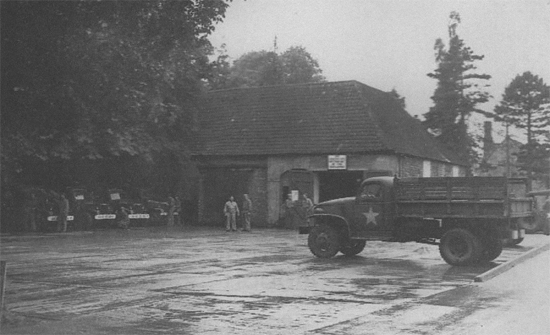
Partial view of the Motor Pool, 162d General Hospital, Nocton Hall, England. Front and rear bumpers of the vehicles are painted white.
The Hospital was able to obtain a large PA system that was installed on the roof of the Post Theater. It helped distribute concerts and news programs across the organization. A RCAF orchestra also gave some excellent concerts. Recreational facilities had been greatly enhanced with the procurement of gym equipment, and baseball and volley ball games were played almost every evening.
As census further declined, a schedule was set up for teaching Enlisted Men Rehabilitation procedures, such as static contraction and remedial exercises. Further classes were conducted including one for the I & E Officer (Information and Education). The “Army Education Program” was further expanded, using as its guide, Circular No. 360, War Department, September 1944, consisting of Phase II, to be employed 60 days after V-E Day.
During the above period, there seemed to be a never-ending line of inspectors and consultants visiting the 162d General Hospital. On 11 April 1945, Lt. Colonel M. K. Schafer, ANC, (Director of Nurses, UK Base) inspected several departments of the organization. She met the entire female personnel and made some minor suggestions to be incorporated into the running organization. Another monthly inspection tour by Major H. J. Bradley on 24 April stated that “… most Departments were superior with an overall rating of excellent …” One of the last inspections was run by First Lieutenant W. F. Thayer and First Lieutenant E. R. Gillespie from Headquarters, Eastern Area, United Kingdom Base, on 3 May 1945. They submitted a very commendatory report.
Above concise Unit History was extracted from Historical Reports, Headquarters, 162d General Hospital, APO 514, US Army, 1944-45, generously provided to the MRC Staff by Lynn F. McNulty, son of Captain Frederick J. McNulty (ASN: O-526873) a Medical Officer who served with various medical units in World War 2 including the one described above. The illustrations contained in the texts were also provided by Lynn, for which our sincere thanks.
